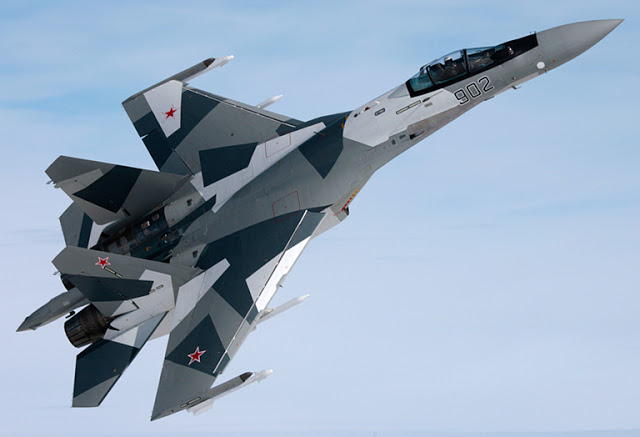“Lengthy negotiations have concluded in a contract to supply 24 Su-35 multi-purpose fighters to China,” Rostec CEO Sergey Chemezov was quoted as saying by Russian daily newspaper Kommersant on 19 November.
The Sukhoi Su-35 (NATO reporting name: Flanker-E) is a designation for two separate, heavily upgraded derivatives of the Su-27 ‘Flanker’. They are single-seat, twin-engine, supermaneuverable multirole fighters, designed by Sukhoi and built by Komsomolsk-on-Amur Aircraft Production Association. The Su-35 is also known as Super Flanker.
The Russian Air Force has ordered 48 production units, designated Su-35S, of the newly revamped Su-35. Both Su-35 models are marketed to many countries, including Brazil, China, India, Indonesia, and South Korea. Sukhoi originally projected that it would export more than 160 units of the second modernized Su-35 worldwide.
While the aircraft maintains a strong superficial resemblance to the Su-27, the airframe, avionics, propulsion and weapons systems of the Su-35 have been thoroughly overhauled. Technological advancements have produced more compact and lighter hardware, such as the radar, shifting the centre of gravity to the aircraft’s rear. These improvements removed the need for canards and saw the abandonment of the “tandem triplane” featured on several Su-27 derivatives. Also omitted was the Su-27’s dorsal airbrake, which was replaced by differential deflection of the vertical stabilizers. Other aerodynamic refinements include a height reduction of the vertical stabilizers, a smaller aft-cockpit hump, and shorter rearward-projecting “sting”.
The reinforced airframe sees extensive use of titanium alloys, increasing its durability to some 30 years or 6,000 service hours, and raising the maximum takeoff weight to 34.5 tonnes.Internal fuel capacity was increased by more than 20% to 11.5 tonnes, and could be raised to 14.5 tonnes with the addition of drop tanks; in-flight refueling can also be used to extend missions.
Sukhoi has overhauled the avionics suite, at the heart of which is the information management system that greatly enhances man-machine interaction.
The Su-35 employs an Irbis-E passive electronically scanned array radar that constitutes an essential component of the aircraft’s fire-control system. The radar is capable of detecting a 3-square-metre (32 sq ft) aerial target at a distance of 400 km (250 mi), and can track 30 airborne targets and engage eight of them at the same time. Su-35S uses the N135 Irbis passive antenna array with electronic scanning radar for improved locating. The radar can also map the ground using a variety of modes, including the synthetic aperture mode. The Irbis-E is complemented by an OLS-35 optoelectronic targeting system that provides laser ranging, TV, Infra-red search and track (IRST) functionality. The Su-35 is compatible with a multitude of long- and short-range air-to-air missiles, precision and unguided air-to-ground weaponry that include missiles, fuel-air bombs and rockets. A maximum weapon payload of 8 tonnes can be carried on the fourteen hardpoints. The fighter may use missiles with a range of up to 300 km.
The Su-35 is powered by a pair of izdeliye 117S (AL-41F1S) turbofan engines. Developed jointly by Sukhoi, NPO Saturn and UMPO, the engine is a heavily upgraded AL-31F variant, and draws on the design of the fifth-generation PAK FA’s Saturn 117 (AL-41F1) engines. Its thrust output is estimated at 142 kN (31,900 lbf), 20 kN (4,500 lbf) more than the Su-27M’s AL-31F.
The engine gives the Su-35 limited supercruise capability, or sustained supersonic speed without the use of afterburners.[49] Radar-absorbent material is applied to the engine inlets and the front stages of the engine compressor to halve the Su-35’s frontal radar cross-section (RCS); the canopy was also modified to deflect radar wave.
SOURCE – Janes, Wikipedia

Brian Wang is a Futurist Thought Leader and a popular Science blogger with 1 million readers per month. His blog Nextbigfuture.com is ranked #1 Science News Blog. It covers many disruptive technology and trends including Space, Robotics, Artificial Intelligence, Medicine, Anti-aging Biotechnology, and Nanotechnology.
Known for identifying cutting edge technologies, he is currently a Co-Founder of a startup and fundraiser for high potential early-stage companies. He is the Head of Research for Allocations for deep technology investments and an Angel Investor at Space Angels.
A frequent speaker at corporations, he has been a TEDx speaker, a Singularity University speaker and guest at numerous interviews for radio and podcasts. He is open to public speaking and advising engagements.


